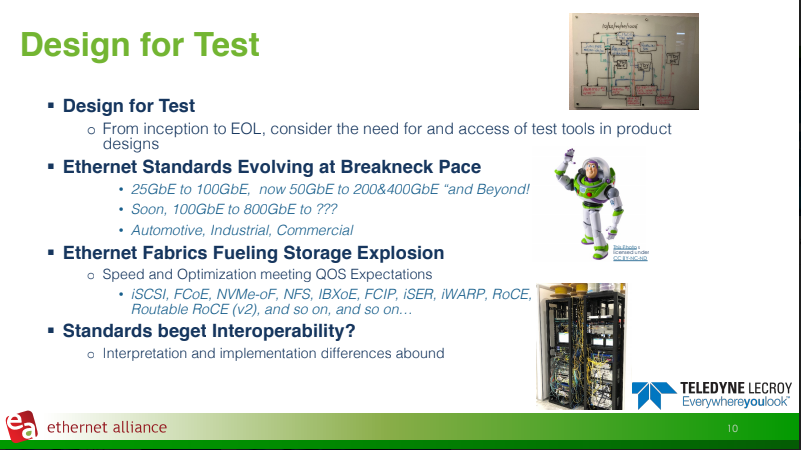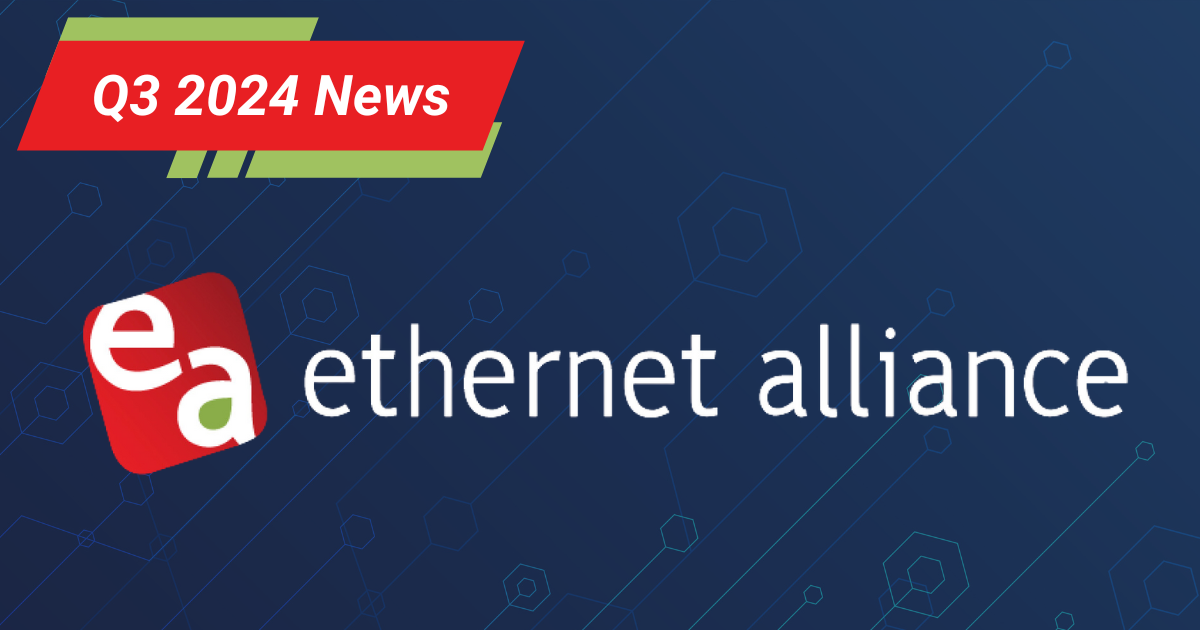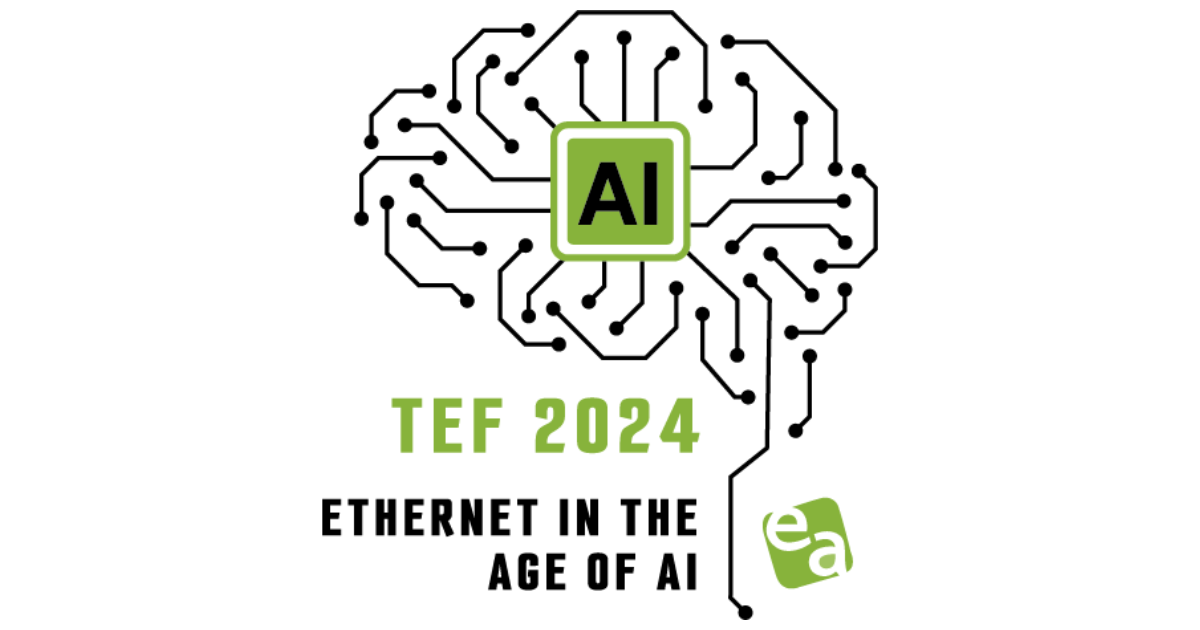Test & Measurement: Planning for Performance: TEF 2021 Panel Q&A – Part 2
David Rodgers, Ethernet Alliance Events Chair and Teledyne LeCroy
Francois Robitaille, EXFO
John Calvin, Keysight Technologies
Steve Rumsby, Spirent
Market Drivers Impacting Test & Measurement
The final day of the Ethernet Alliance’s TEF21: The Road Ahead forum was punctuated by a lively discussion on performance planning in test and measurement.
In Test & Measurement: Planning for Performance panel discussion, moderator and Ethernet Alliance Events Chair David Rodgers of Teledyne LeCroy, along with panelists John Calvin of Keysight Technologies (Validating Methods for Emerging 106Gbps Electrical and Optical Specifications relating to IEEE P802.3cu/P802.3ck); Steve Rumsby, Spirent (Recommended Design Practices for the Next Generation Ethernet Rate); and Francois Robitaille, EXFO (Full Compliance Validation of Next-Gen Transceivers) explored the diverse market drivers influencing test and measurement.
The panel emphasized critical impacts, from increased signaling speeds, to growing port counts with higher density, to standards and interoperability conformance. Discussions of the current state of play, and how test and measurement must evolve to keep pace with market and technology demands attracted strong audience interest and reaction.
At the presentation’s conclusion, panelists answered numerous questions about the test and measurement developments needed to address escalating speed and bandwidth requirements of the next era of Ethernet. Their insightful responses are captured below in the second of this two-part series.
 Importance of Interoperability in Test & Measurement
Importance of Interoperability in Test & Measurement
David J. Rodgers: Does the Ethernet Alliance offer opportunities for interop testing, and could you share some recent examples?
David J. Rodgers: I can answer that. Yes, for the last six, seven years, I’ve been participating directly with the EA on a variety of these interop events. The goal of these public demonstrations of our technologies is showcasing seamless interoperability, for example, doing things like building out a show network with live fiber drops of 400Gb and FlexE traffic at OFC, all going to a variety of different booths. I know that one of the Ethernet Alliance missions is to promote interoperability. But from your perspective, what other opportunities are you aware of, or would you like to see?
Francois Robitaille: If I look from a test and measurement perspective and the physical layer point of view, I think it comes back to getting some kind of data exchange between the testing tools that would allow you to see how much of the process optimization you could generate. Maybe some machine learning tools that you could apply between the different test solutions you have. I think that could be an interesting approach, which has not been done, and really is coming to silicon photonics. This is going to be part of the manufacturing process now at every stage, and everybody will face the same issue. So why not try to see if we cannot get some interoperability between the vendors to improve that process for everybody?
David J. Rodgers: We know that the IEEE is dealing with a lot of the specifications and a lot of electrical things in there. But in the OIF, as another standards body, do you think that there’s an appetite for specification compliance and conformance testing against standards in that arena for optics?
Francois Robitaille: I would say yes knowing the fundamental objective of the OIF is to make sure we have commercial, viable, economical solutions. One way to do that obviously, is to standardize as much as possible and interchange vendors as much as possible. It’s kind of fundamental, so definitely yes. That’s what we see with all the MSAs, the multi-supplier agreements that the OIF is coming up with. There is definitely a bit more of a push at the OIF in that direction, definitely.
David J. Rodgers: Should we establish in the test and measurement (T&M) community a common interface where you could aggregate the information from a variety of test tools in a common format?
Francois Robitaille: We’ve been approached by one of our customers saying, “I’m getting this data from one vendor. I’m not even sure if I’m getting it from a second vendor. There’s no standard. There’s no uniformity between the vendors. My supplier A is working with that brand of instrument, and supplier B is working with that brand of instrument, and I’m not even sure if I can compare things.” So there is absolutely no standardization at the test and measurement level, at least on the optical side. Electrical scopes, looking at LXI or things like this, you have classes of instruments which need to match some standards. It doesn’t exist in optics, so it’s kind of the wild west world at this point. I think it would be beneficial for the industry if we could get to that level.
John Calvin: In the direction we’re heading – co-package optics – I think we’re going to see a stronger reliance on optical interoperability. We use tools today that evaluate optical performance with fundamental measurements. Those are important measurements, but typically, those are used in qualifying devices. You don’t see those in an interoperability setting – that vendor A’s device with vendor C’s fiber can present vendor D’s device with a sufficiently high amplitude signal for it to receive the error-free. That’s where I believe we need to get. I can foresee an optical interop event, a dedicated optical interop event where we start to break ground here.
Steve Rumsby: I think those are some good points. On the electrical side, having the right data and maybe harmonization of that data so we have some uniformity is a fun idea. But the 800-pound gorilla here is Covid-19, right? Collaboration got really hard, really quick. So how do we interop in this new world? I think it’s really about having that data and sharing it in an effective way. As artificial intelligence machine learning, how do you take that data and create useful insights that in turn enable good decisions. I think it’s about the data, and again, possible harmonization.
David J. Rodgers: Any closing thoughts before we wrap it up? 
Francois Robitaille: We do have challenges ahead of us. I think 400Gb was definitely an important milestone that we’re going through at the moment. 800Gb will bring more challenges on top of this. I think it’s becoming a challenge, even from the test gear itself, to meet the requirements. Partnering between the manufacturers, the test and measurement vendors, is going to become fundamental to get things done.
Steve Rumsby: It’s a really exciting time for us in the T&M industry. As you know, we really are trailblazing on that path to 800GbE. It’s time to take things like the IEEE 802.3ck standard and make it real. That’s an exciting time and I’m happy to be a part of it. I look forward to enabling the ecosystem.
John Calvin: In this business we need to be the optimists, because there’s always a clever way to move to the next speed generation. There are incredibly bright people in this community, and we’ll see novel and genius ways to get to 224Gb, I’m absolutely certain. It may very well require some reinvention on the test and measurement side, and that’s okay. That’s really an okay thing, and that keeps the test and measurement community on target, you know. This is the kind of feedback we need to do our job and do our job correctly.
The closing comment I really wanted to leave with people is, we need to do more to cultivate this science that we all immerse ourselves in, this physical layer of validation. Whether it be in optics or in protocol or in hardcore electrical stuff, this is something that a lot of people out of school are finding not that interesting, and we see a drop off of people playing in the space. I think we as an industry need to recognize that. Unless it’s going to be a bunch of old guys doing these measurements, we need to cultivate the next generation and get young people interested in this space. I think there’s fascinating problems, fascinating issues here, that get me excited every day, and I think other people could get excited about as well, if we work to really communicate and help people learn about this space. It’s not that hard to get your mind around this. We want to invite as many participates as we possibly can, because that’s where the novel and the genius ideas come from.
To access TEF21: Test & Measurement: Planning for Performance on demand, and all of the TEF21 on-demand content, visit the Ethernet Alliance website.





